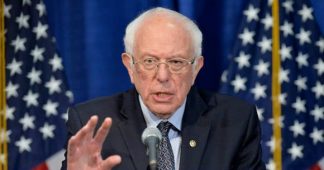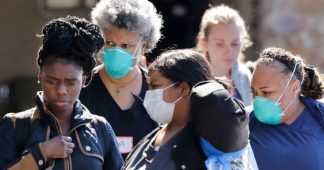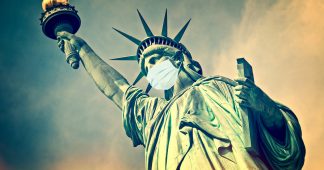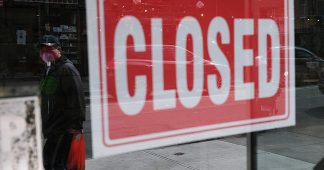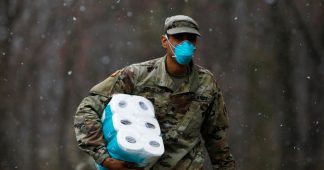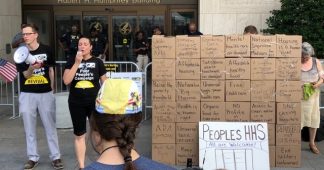The Current Situation in the United States: May 2020
James K. Galbraith
Two weeks ago week the US death toll from Covid-19 exceeded that of US soldiers in Vietnam, 1955-1974. On May 1 the one-day toll reached a new high, greater than that in New York City on September 11, 2001. Meanwhile economic output has collapsed and over thirty million Americans had filed unemployment claims as of April 30, 2020. On the public health front, testing remains inadequate, contact tracing non-existent, treatment options appear stalled and millions remain uninsured. The federal bailouts have worked well in one way only: to spur a modest revival of stocks and to forestall massive defaults on bonds.
The failures of the public health system border on sabotage. Test kits were available from the WHO in January; the US elected not to use them. The first production of tests from the CDC was botched. Testing was deliberately limited as community transmission grew, so that the virus escaped from early containment that might have been possible. Lockdowns and quarantines came late, were poorly organized and weakly enforced. Supplies of PPE were not allocated to hospitals and health care providers according to need; the Defense Production Act was not deployed in timely and effective manner to ramp up home production; no effective federal system to manage international medical supply chains exists to this day. While some firms have no doubt done their best, reports of profiteering and scams are rampant.
The push to reopen the economy is a further mark of failure. As food supply workers were not properly protected, unacceptable levels of sickness and workplace contamination have occurred, notably in meat. Food banks are in crisis, while milk, eggs and other perishables are wasted. State governments facing fiscal catastrophe press businesses to reopen on terms that cannot be profitable, because capacity is constrained for health reasons. The openings are calculated to force workers off of unemployment insurance, which can be revoked if they decline to return to risky jobs. Many smaller businesses are deciding not to reopen; they will face bankruptcy instead and disappear. Although evictions and foreclosures are technically deferred, many landlords have ignored this and in any event rent, mortgages, utility bills and other debts continue to accrue.
Models of the pandemic now openly predict infections rising further as lockdowns are relaxed, to the point of testing the capacity of health care systems even in parts of the country not yet severely affected. Whether this will happen or not is not yet clear; the public may continue, as a general rule, to practice safe contact behavior, and if the transmission rates hold below 1, as they presently are estimated to be in almost all of the American states, the pandemic may continue to decline. But if the models are borne out, death rates will rise by many multiples of their current values. These events are projected to lead to further lock-downs on a rolling basis, until such time as a vaccine or therapy is available. There is no guarantee of either.
Even if the pandemic is now contained the economy will not revert to “normal.” The United States is a premier producer of energy, aerospace, advanced information technologies and financial services. It assembles many million automobiles, appliances and other consumer durable goods every year. The oil sector has suffered a price collapse and borders now on mass bankruptcy; when fracking wells are capped they will sand up and become very costly to reopen, so the US energy-based economic expansion is over. Airplanes are lined up in parking spaces; no new civilian passenger airliners will be needed indefinitely. Households who are either unemployed or working from home (and therefore not commuting) or that face deferred rent and mortgages will not soon be in the market for new cars; in any event the old ones will last longer as they are being driven much less. As office buildings remain empty, new ones will not be built. Similarly for retail stores, already driven to the wall by on-line ordering and deliveries. The banking sector is on the hook for energy loans gone bad, and for household debts, and for corporate loans that will be at risk once the bailout money runs low. The debts built up during the pandemic will be defaulted in many cases, ruining credit for the households affected. All of which foretells a long depression even under the best foreseeable public health conditions. A cycle of infections and lock-downs will make all of this that much worse.
There is an illusion about, that the recent prosperity can be revived by “reopening.” But many industries – aircraft, airlines, hotels, automobiles, appliances, commercial construction, energy – will definitely shrink, whatever happens now and no matter how much money they receive. The bailouts were a measure predicated on the idea that these industries were facing just a temporary interruption. But it is difficult to see how bankruptcies and liquidations can be avoided if there is no revival in the demand for product. And large-scale production relies on interlinked supply-chains, so that if a single major producer (for example one of the majors in the automotive sector) fails, there is a risk of cascading liquidations (for example in auto parts), making operations difficult – perhaps impossible – for the survivors. In these industries the supply chains and subcontractors are much larger in the aggregate than the assembly operations of the final production firm.
Higher education, a large sector in America, faces a crisis of high costs, collapsing enrollments and the actual alternative of cheap on-line instruction in many fields. This was already in the works for demographic reasons, and is now being accelerated by the loss of household wealth. Health care, ten times larger, also faces financial difficulties as millions are losing their insurance and – for the moment anyway – as accidents, other infectious diseases and such are down, depriving doctors and hospitals of reimbursements. Service industries from restaurants to retailers cannot function profitably at one-quarter of capacity; bars, nightclubs, and most sporting venues cannot reopen at all.
Federal decision-making has failed at every level. In the executive branch, it has been at best a complex of incompetence, denial, and political motivation. At worst, decisions were taken and are still being taken in full knowledge of the projected death rates and potential for private profiteering, both in the medical sector and in the larger financial economy. It is known that some private speculators made over three hundred billion dollars shorting the stock market before the February collapse, and that some Members of Congress sold their holdings based on information provided in intelligence briefings. Congressional action has been slow, marred by politics, lobbies, regional rivalries, poor judgment and a misdiagnosis of the economic issues, as Congress reached for legislative models used in past business downturns, especially the crisis of 2007-2009, which had no quarantine or other public health component.
The specific policies implemented were plagued by problems. To calculate payments under the first CARES Act, the IRS had to use filings from tax year 2018, and also ran into printing bottlenecks for paper checks that had to be mailed to those without direct deposit. Unemployment insurance benefits were made relatively generous, and the state unemployment insurance web-sites could not handle the crush, so they crashed, leaving many without the ability to access the program. Instead of simple wage replacement (which would have protected health insurance and union membership) the Small Business Administration issued rules that appeared unusable for many firms, banks gave preference to favored clients, and in the first round also the money soon ran out. In short, the effort to save the economy by pouring money into it through conventional channels was inadequate, ill-considered, inefficient, and in some respects corrupt. The best that may be said is that it was much better than doing nothing at all.
As events progress, the usual pattern of property sales and purchases cannot proceed. So property values will collapse, leaving millions of homeowners without equity; as this happens, mass foreclosures and property seizures are inevitable under the present legal rules. Predatory private investors will buy distressed assets at firesale prices and the American population will revert, largely to renter status. For those with means, private tutors and doctors will remain available; the others will manage as they can. Needless to say, depression, despair, drug abuse and suicide will prevail.
Or maybe they won’t. In the wake of the Great Financial Crisis, it was possible – barely possible, but possible – to shift the blame from the bankers to the victims, from those who built a massively fraudulent financial system to those who took out the loans that they could not repay. But there was no viral element, no public health trigger, to that crisis. This one is different. Every development described above is a consequence, direct or indirect, of the coronavirus. Those who were laid off, and who went home, and who broke the transmission of the disease, did their part, just as health-care professionals and grocery clerks did theirs. Their legal case for relief remains weak. But the moral case is strong and the economic case is beyond dispute. Even the incumbent Treasury Secretary, Steven Mnuchin, a foreclosure-predator of the first water after 2008, has stated that the economic crisis “is no fault of American business, it is no fault of American workers, it is the fault of a virus.” This is true but it does not mean that things will return to the past if the virus can be made to go away.
To move forward, first of all, debts incurred before and during the pandemic will have to be written down. The energy sector and transport sectors will have to be rebuilt, based far more on renewables and sources other than oil. A large share of basic industries – especially in the health sector – will have to be repatriated so that basic sufficiency exists in this country. Millions of people will be needed to monitor and support public health; jobs for them must be organized and funded by the government. State and local governments will have to be federally-funded, in substantial part, to provide basic public services. New and sustainable housing must be built, in new community structures. High speed broadband must be provided to all. A new financing model – cooperative, with public support – will be required to re-establish small businesses. Local, decentralized cultural and sporting venues will have to replace mass-based experiences; these too will require cooperative structures and public support. In short, the only way out, remotely acceptable to the population at large, will require a comprehensive restructuring of the economy on a cooperative foundation, with the government stepping up to guaranteed funding, employment, and public investments.
Disaster capitalism is being tried, and the worst case is now the likely case. But there is a scale beyond which disaster capitalism cannot go. At a certain point, the carnage becomes too great to neglect, impossible to avoid and lethal to overlook. At a certain point, ordinary people will stand up and refuse to be bullied any more. That point has not quite arrived; we are still in the mind-set of “getting back to normal,” even as the pandemic continues. The contradiction between normality and public health is on people’s minds; the impossibility of returning to the previous abnormal-normal has not yet settled in. It will, in due course. At that point, the question of alternatives will have to be faced.
